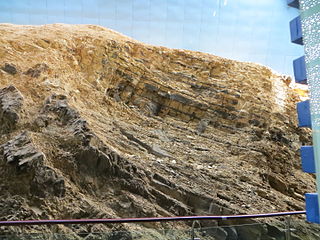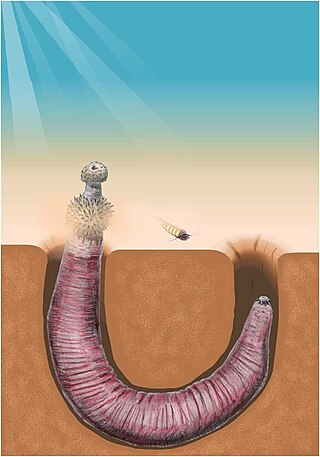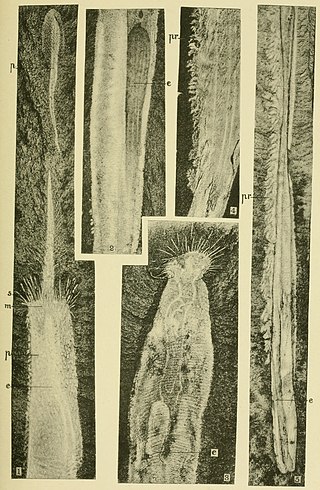Related Research Articles

The Burgess Shale is a fossil-bearing deposit exposed in the Canadian Rockies of British Columbia, Canada. It is famous for the exceptional preservation of the soft parts of its fossils. At 508 million years old, it is one of the earliest fossil beds containing soft-part imprints.

Vetulicolia is a clade of bilaterian animals encompassing several extinct species belonging to the Cambrian period. The clade was created by Degan Shu and his research team in 2001, and named after Vetulicola cuneata, the first species of the phylum described in 1987.

Hallucigenia is a genus of lobopodian known from Cambrian aged fossils in Burgess Shale-type deposits in Canada and China, and from isolated spines around the world. The generic name reflects the type species' unusual appearance and eccentric history of study; when it was erected as a genus, H. sparsa was reconstructed as an enigmatic animal upside down and back to front. Lobopodians are a grade of Paleozoic panarthropods from which the velvet worms, water bears, and arthropods arose.

The Maotianshan Shales (帽天山页岩) are a series of Early Cambrian sedimentary deposits in the Chiungchussu Formation, famous for their Konservat Lagerstätten, deposits known for the exceptional preservation of fossilized organisms or traces. The Maotianshan Shales form one of some forty Cambrian fossil locations worldwide exhibiting exquisite preservation of rarely preserved, non-mineralized soft tissue, comparable to the fossils of the Burgess Shale of British Columbia, Canada. They take their name from Maotianshan Hill in Chengjiang County, Yunnan Province, China.
Pikaia gracilens is an extinct, primitive chordate animal known from the Middle Cambrian Burgess Shale of British Columbia. Described in 1911 by Charles Doolittle Walcott as an annelid, and in 1979 by Harry B. Whittington and Simon Conway Morris as a chordate, it became "the most famous early chordate fossil", or "famously known as the earliest described Cambrian chordate". It is estimated to have lived during the latter period of the Cambrian explosion. Since its initial discovery, more than a hundred specimens have been recovered.
Derek Ernest Gilmor Briggs is an Irish palaeontologist and taphonomist based at Yale University. Briggs is one of three palaeontologists, along with Harry Blackmore Whittington and Simon Conway Morris, who were key in the reinterpretation of the fossils of the Burgess Shale. He is the Yale University G. Evelyn Hutchinson Professor of Geology and Geophysics, Curator of Invertebrate Paleontology at Yale's Peabody Museum of Natural History, and former Director of the Peabody Museum.

Anomalocaris is an extinct genus of radiodont, an order of early-diverging stem-group arthropods.

Odaraia is a genus of bivalved arthropod from the Middle Cambrian. Its fossils, which reach 15 centimetres (5.9 in) in length, have been found in the Burgess Shale in British Columbia, Canada.

Chengjiang is a city located in Yuxi, Yunnan Province, China, just north of Fuxian Lake.

Deuterostomes are bilaterian animals of the superphylum Deuterostomia, typically characterized by their anus forming before the mouth during embryonic development. Deuterostomia is further divided into four phyla: Chordata, Echinodermata, Hemichordata, and the extinct Vetulicolia known from Cambrian fossils. The extinct clade Cambroernida is thought to be a member of Deuterostomia.
The fossils of the Burgess Shale, like the Burgess Shale itself, are fossils that formed around 505 million years ago in the mid-Cambrian period. They were discovered in Canada in 1886, and Charles Doolittle Walcott collected over 65,000 specimens in a series of field trips up to the alpine site from 1909 to 1924. After a period of neglect from the 1930s to the early 1960s, new excavations and re-examinations of Walcott's collection continue to reveal new species, and statistical analysis suggests that additional discoveries will continue for the foreseeable future. Stephen Jay Gould's 1989 book Wonderful Life describes the history of discovery up to the early 1980s, although his analysis of the implications for evolution has been contested.

Archaeopriapulida is a group of priapulid worms known from Cambrian lagerstätte. The group is closely related to, and very similar to, the modern Priapulids. It is unclear whether it is mono- or polyphyletic. Despite a remarkable morphological similarity to their modern cousins, they fall outside of the priapulid crown group, which is not unambiguously represented in the fossil record until the Carboniferous. In addition to well-preserved body fossils, remains of several archaeopriapulid taxa are known to have been preserved primarily as organic microfossils, such as isolated scalids and pharyngeal teeth. They are probably closely related or paraphyletic to the palaeoscolecids; the relationship between these basal worms is somewhat unresolved.

The Burgess Shale, a series of fossil beds in the Canadian Rockies, was first noticed in 1886 by Richard McConnell of the Geological Survey of Canada (GSC). His and subsequent finds, all from the Mount Stephen area, came to the attention of palaeontologist Charles Doolittle Walcott, who in 1907 found time to reconnoitre the area. He opened a quarry in 1910 and in a series of field trips brought back 65,000 specimens, which he identified as Middle Cambrian in age. Due to the quantity of fossils and the pressures of his other duties at the Smithsonian Institution, Walcott was only able to publish a series of "preliminary" papers, in which he classified the fossils within taxa that were already established. In a series of visits beginning in 1924, Harvard University professor Percy Raymond collected further fossils from Walcott's quarry and higher up on Fossil Ridge, where slightly different fossils were preserved.

Vetulicola cuneata is a species of extinct animal from the Early Cambrian Chengjiang biota of China. It was described by Hou Xian-guang in 1987 from the Lower Cambrian Chiungchussu Formation, and became the first animal under an eponymous phylum Vetulicolia.
The Phyllopod bed, designated by USNM locality number 35k, is the most famous fossil-bearing member of the Burgess Shale fossil Lagerstätte. It was quarried by Charles Walcott from 1911–1917, and was the source of 95% of the fossils he collected during this time; tens of thousands of soft-bodied fossils representing over 150 genera have been recovered from the Phyllopod bed alone.

Louisella is a genus of worm known from the Middle Cambrian Burgess Shale. It was originally described by Charles Walcott in 1911 as a holothurian echinoderm, and represents a senior synonym of Miskoia, which was originally described as an annelid. 48 specimens of Louisella are known from the Greater Phyllopod bed, where they comprise < 0.1% of the community. It has been stated to have palaeoscolecid-like sclerites, though this is not in fact the case.

Saccorhytus is an extinct genus of animal possibly belonging to the superphylum Ecdysozoa, and it is represented by a single species, Saccorhytus coronarius. The organism lived approximately 540 million years ago in the beginning of the Cambrian period. Initially proposed as a deuterostome, which would make it the oldest known species of this superphylum, it has since been determined to belong to a protostome group called the ecdysozoans.

Saccorhytida is an extinct phylum of Cambrian possibly belonging to the superphylum Ecdysozoa. It contains three monotypic genera: its namesake Saccorhytus, the dubious Clypecella and Beretella. All three genera are found in the early Cambrian of China.

Hallucigeniidae is a family of extinct worms belonging to the group Lobopodia that originated during the Cambrian explosion. It is based on the species Hallucigenia sparsa, the fossil of which was discovered by Charles Doolittle Walcott in 1911 from the Burgess Shale of British Columbia. The name Hallucigenia was created by Simon Conway Morris in 1977, from which the family was erected after discoveries of other hallucigeniid worms from other parts of the world. Classification of these lobopods and their relatives are still controversial, and the family consists of at least four genera.
The Cambrian chordates are an extinct group of animals belonging to the phylum Chordata that lived during the Cambrian, between 538 and 485 million years ago. The first Cambrian chordate known is Pikaia gracilens, a lancelet-like animal from the Burgess Shale in British Columbia, Canada. The discoverer, Charles Doolittle Walcott, described it as a kind of worm (annelid) in 1911, but it was later identified as a chordate. Subsequent discoveries of other Cambrian fossils from the Burgess Shale in 1991, and from the Chengjiang biota of China in 1991, which were later found to be of chordates, several Cambrian chordates are known, with some fossils considered as putative chordates.
References
- ↑ "Honorary doctorates - Uppsala University, Sweden".
- ↑ BioLogos (2013). "Simon Conway-Morris". The BioLogos Foundation. Archived from the original on 12 June 2011. Retrieved 23 July 2013.
- ↑ "The Nature of Nature". Conference on the Role of Naturalism in Science. 12 April 2000. Retrieved 20 February 2010.
- ↑ "Charles Doolittle Walcott Medal". National Academy of Sciences. Archived from the original on 13 May 2011. Retrieved 14 February 2011.
- ↑ "Lyell Medal". The Geological Society of London. Retrieved 16 May 2022.
- ↑ "Bag-like sea creature was humans' oldest known ancestor". 30 January 2017. Retrieved 31 January 2017.
- ↑ Han, Jian; Conway Morris, Simon; Ou, Qiang; Shu, Degan; Huang, Hai (2017). "Meiofaunal deuterostomes from the basal Cambrian of Shaanxi (China)". Nature. 542 (7640): 228–231. Bibcode:2017Natur.542..228H. doi:10.1038/nature21072. ISSN 0028-0836. PMID 28135722. S2CID 353780.
- ↑ Yunhuan Liu; Emily Carlisle; Huaqiao Zhang; Ben Yang; Michael Steiner; Tiequan Shao; Baichuan Duan; Federica Marone; Shuhai Xiao; Philip C. J. Donoghue (2022). "Saccorhytus is an early ecdysozoan and not the earliest deuterostome". Nature. 609 (7927): 541–546. Bibcode:2022Natur.609..541L. doi:10.1038/s41586-022-05107-z. hdl: 1983/454e7bec-4cd4-4121-933e-abeab69e96c1 . PMID 35978194. S2CID 251646316.
- 1 2 3 "Boyle Lecture 2005: Darwin's Compass" (PDF). St Mary-le-Bow. 2005. Retrieved 20 February 2010.
- ↑ "Summer Course No. 1 – Unit 1: The Big Questions in Science and Religion – St Edmund's College, Cambridge: July 16–22, 2006". The Faraday Institute for Science and Religion. 2006. Archived from the original on 7 June 2011. Retrieved 20 February 2010.
- ↑ "News & Events". The University of Edinburgh. Archived from the original on 9 April 2008. Retrieved 20 February 2010.
- ↑ The points cited are taken from the official abstracts of the "Gifford Lectures 2006 –" (PDF). University of Edinburgh. Archived from the original (PDF) on 20 March 2007. Retrieved 20 February 2010.
- ↑ "CNS Story: Organisms' common ancestry aids medical research, says biologist". Archived from the original on 10 March 2009. Retrieved 6 July 2011.
- ↑ NNDB. "Simon Conway Morris". nndb.com. Soylent Communications. Retrieved 23 July 2013.